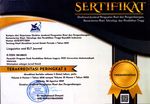Phonetic Proficiency in /r/ Pronunciation: A Case Study of Chinese Students Learning Indonesian
Abstract
Keywords
Full Text:
PDFReferences
L. Muliastuti, “Strategi dan kebijakan pengajaran BIPA,” in Presented at the Workshop on Basic and Intermediate Level BIPA Training at UNY, 2016.
D. Maulipaksi, “Program Bahasa Indonesia bagi Penutur Asing (BIPA) akan miliki standar baku.” 2016. [Online]. Available: https://www.kemdikbud.go.id/main/blog/2016/04/program-bahasa-indonesia-bagi-penutur-asing-bipa-akan-miliki-standar-baku
R. Jannah and P. G. Yanti, “Pembelajaran bahasa Indonesia bagi penutur asing menggunakan metode Darmawisata,” Imajeri: Jurnal Pendidikan Bahasa dan Sastra Indonesia, vol. 2, no. 2, pp. 182–189, 2020, doi: 10.22236/imajeri.v2i2.5096.
Wojowasito, Pengajaran bahasa kedua (Bahasa asing, bukan bahasa ibu). Bandung: Shinta Dharma, 1997.
S. T. Nugraha, “Kesalahan-kesalahan berbahasa Indonesia pembelajar bahasa Indonesia sebagai bahasa asing: Sebuah penelitian pendahuluan,” Jurnal KIPBIPA IV, pp. 1–22, 2000, [Online]. Available: http://staffnew.uny.ac.id/upload/132313273/pendidikan/JENIS+KESALAHAN+BERBAHASA.pdf
J. C. Catford, Fundamental problems in phonetics. Edinburgh: University Press, 1997.
R. L. Trask, A dictionary of phonetics and phonology. London: Routledge, 1996.
A. M. Delforge, “Not correct but not bad either: Another look at the social meaning of ‘velar r’ in Puerto Rican Spanish,” in Selected proceedings of the 6th Workshop on Spanish Sociolinguistics, 2013, pp. 158–168.
A. L. Dauphinais-Civitello, “Retroflex /r/ and incomplete neutralization in Puerto Rican Spanish,” 2018.
C. Graml, “‘Puerto RICO en variación’: Variation, socio-phonétique et son auto-et heterosurveillance par les locuteurs - le cas de la vélarisation du /r/ en espagnol portoricain,” Ludwig-Maximilians Universität, Germany, 2009.
J. C. Holmquist, “Coffee farmers, social integration and five phonological features: Regional socio-dialectology in West-Central Puerto Rico,” in Selected proceedings of the First Workshop on Spanish Sociolinguistics, 2003, pp. 70–76.
J. C. Holmquist, “Gender in context: Features and factors in men’s and women’s speech in rural Puerto Rico,” in Selected proceedings of the 4th Workshop on Spanish Sociolinguistics, 2008, pp. 17–35.
H. López-Morales, “Velarización de /rr/ en el español de Puerto Rico: Índices de actitud y creencias,” Dialectología y sociolingüística: Temas puertorriqueños, pp. 107–130, 1979.
H. López-Morales, “Lateralización de -/r/ en el español de Puerto Rico: Sociolectos y estilos,” in Philologica Hispaniensia in honorem Manuel Alvar I: Dialectología, 1983.
H. López-Morales, “A propósito de la sociolingüística aplicada: La /rr/ velar en el español de Puerto Rico,” Español Actual: Revista de Español Vivo, vol. 80, pp. 7–13, 2003.
A. Medina-Rivera, “Variación fonológica y estilística en el español de Puerto Rico,” University of Southern California, 1997.
T. Navarro-Tomás, El español en Puerto Rico. Río Piedras: Editorial Universitaria, 1948.
P. Ladefoged and I. Maddieson, Sounds of World’s Languages. Oxford: Blackwell, 1996.
B. W. Al-Zalzali and K. Raheem, “English flap and trill /r/ with reference to Arabic,” Nasaq Journal, vol. 34, no. 2, pp. 590–608, 2022, [Online]. Available: https://www.iasj.net/iasj/issue/14534
I. Diani and A. Azwandi, “Phonological change processes of English and Indonesian,” Joall: Journal of Applied Linguistics and Literature, vol. 6, no. 1, pp. 133–148, 2021, doi: 10.33369/joall.v6i1.13642.
A. R. Firdhani L. M. Indrayani and S. Mahdi, “The use of consonant elision by Sri Mulyani during her interview session with the banker,” Eltin Journal: Journal of English Language Teaching in Indonesia, vol. 6, no. 2, pp. 53–58, 2018, doi: 10.22460/eltin.v6i2.p53-58.
S. Nafisah, “Proses fonologis dan pengkaidahannya dalam kajian fonologi generatif,” Deiksis, vol. 9, no. 1, pp. 70–78, 2017, doi: 10.30998/deiksis.v9i01.940.
R. Kumar, Research methodology: A step-by-step guide for beginners, 5th ed. California: SAGE Publications, 2019.
U. Sekaran and R. Bougie, Research methods for business: A skill-building approach, 8th ed. West Sussex: Wiley, 2020.
Sugiyono, Metode penelitian kuantitatif, kualitatif, dan R&D. Bandung: Alfabeta, 2018.
H. B. Sutopo, Metode penelitian kualitatif. Surakarta: UNS Press, 2006.
R. A. Sihombing, “Jokowi imbau stok BMM dijaga jelang libur Natal dan Tahun Baru.” 2019. [Online]. Available: https://enamplus.liputan6.com/global/read/4134026/jokowi-imbau-stok-bmm-dijaga-jelang-libur-natal-dan-tahun-baru
B. Bungin, Metodologi penelitian kualitatif dan kuantitatif. Yogyakarta: Gajah Mada Press, 2001.
M. Muslich, Fonologi bahasa Indonesia: Tinjauan deskriptif sistem bunyi bahasa Indonesia. Jakarta: Bumi Aksara, 2014.
L. J. Moleong, Metodologi penelitian kualitatif. Bandung: PT Remaja Rosdakarya, 2010.
R. Ellis, The study of second language acquisition, 2nd ed. Oxford: Oxford University Press, 2008.
G. Barkhuizen, “A narrative approach to exploring context in language teaching,” English Language Teaching Journal, vol. 62, no. 3, pp. 231–293, 2008, doi: 10.1093/elt/ccm043.
R. Rasyad, Metode statistik deskriptif untuk umum. Jakarta: Grasindo, 2002.
DOI: https://doi.org/10.31764/leltj.v11i2.17871
Refbacks
- There are currently no refbacks.
Copyright (c) 2023 Muhammad Nur Arifin

This work is licensed under a Creative Commons Attribution-ShareAlike 4.0 International License.
_____________________________________________________
Linguistics and ELT Journal
p-ISSN 2339-2940 | e-ISSN 2614-8633

LELTJ is licensed under a Creative Commons Attribution-ShareAlike 4.0 International License.
_____________________________________________________
LELTJ is abstracting & indexing in the following databases:
_____________________________________________________
LELTJ Editorial Office:













